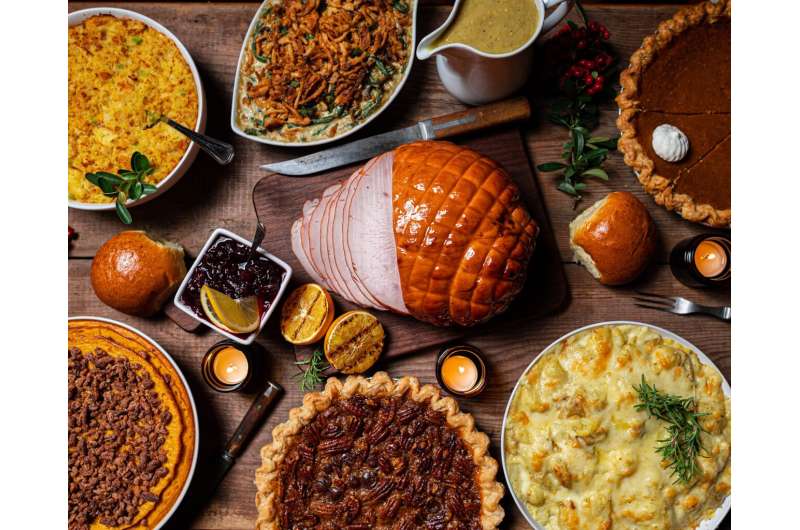Myths about Thanksgiving and nutrition debunked

The feast that officially kicks off the holiday season is almost here. Thanksgiving is steeped in the comfort and familiarity of traditional foods—turkey and gravy, stuffing, cranberry sauce—as well as a few time-worn misconceptions. If you blame the turkey for your after-dinner snooze or feel you've ruined your healthy diet by splurging on pumpkin pie, it's time to set things straight. We're taking on—and debunking—five Thanksgiving feast un-truths.
1. Turkey makes you sleepy: Not really
Turkey contains tryptophan, an amino acid that helps the body produce serotonin, which is involved in regulating sleep cycles. But many protein-rich foods, including chicken, fish, soybeans, and some cheeses, contain as much or more tryptophan by weight than turkey, yet don't have the same reputation for inducing sleepiness.
Post-meal malaise is more likely due to other factors. The high intake of rapidly digested carbohydrates (e.g., white potatoes, stuffing, sugary desserts) at most Thanksgiving meals increases blood sugar quickly. The major boost in insulin released to manage that blood sugar can cause an overcorrection, leading to low blood sugar levels and tiredness.
Our over-full plates could also contribute to post-feast fatigue. The body diverts blood away from other parts of the body to the digestive tract, which can leave us feeling low energy. Let's not forget the sleep-inducing effects of alcoholic beverages or the exhaustion brought on by preparing the feast and the stress involved in entertaining guests.
Try this: To prevent a stupor caused by overindulgence, don't go into the Thanksgiving meal overly hungry. Eat small portions of white potatoes, stuffing, sweetened cranberry sauce, and other sugary treats—and put those carbs to task with an energizing post meal walk instead of a nap.
2. Canned pumpkin is not as nutritious as fresh: They are pretty equivalent
Whether fresh or canned, you really can't go wrong with this flavorful and nutrient-dense winter squash. A single half-cup serving of either fresh or canned pumpkin packs more than 100% of the recommended daily value of vitamin A and is a good source of several other vitamins and minerals, including fiber, vitamin C, iron, and potassium. Choose 100% pumpkin, not cans of pumpkin pie mix, which contain a lot of added sugar, salt, and spices. Using canned pumpkin purée saves time, energy, and even money and might help boost intake of this nutritious food. One definite perk to using fresh pumpkin is the pumpkin seeds, which can be roasted and used in various dishes. Be aware that the flavor of fresh pumpkin might be slightly different than canned, depending on the type of pumpkin used.
Try this: Use 100% pumpkin purée in muffins, pancakes, and savory dishes like soups, overnight oats, casseroles, and pasta sauce. Try making this year's homemade pumpkin pie taste a little more like pumpkin and a little less like sugar.
3. Cranberry sauce is great for health: Not with all that added sugar
For many, a Thanksgiving meal is not complete without cranberry sauce. This celebrated staple might seem to be among the healthiest dishes on the table. It could be—if it weren't for all the added sugar. Whole cranberries, fresh or frozen, are naturally low in sugar, but it takes a lot of added sugar to counter their tartness. Cranberries' distinct flavor, along with their deep crimson color, indicate the presence of many healthful plant compounds. They are also rich in fiber and vitamin C.
Try this: Consider making your own sauce or relish with less sugar. Experiment with ingredients like fresh or dried fruit, citrus zest, unsweetened fruit preserves, vanilla or almond extract, and cinnamon to help cut the sugar when making this year's cranberry side-dish.
4. The bird is done when the juices run clear: No—use a meat thermometer
Myoglobin, the pigment that causes the pink color in a turkey's juices, becomes clear when heated. But the color of the juices is not a reliable way to avoid giving your guests food poisoning. According to the USDA, poultry is done when its internal temperature reaches 165°F. The best way to check for doneness is to use a meat thermometer.
Try this: Remove the turkey from the oven and check the temperature by inserting a meat thermometer horizontally into the thickest part of the breast and the innermost part of the thigh, making sure not to let the thermometer touch bone. When the minimum internal temperature of 165°F is reached, remove the bird from the oven and let it rest (20–40 minutes, depending on size) so the juices reabsorb and keep the meat moist. Note that it is not safe to cook poultry in an oven set lower than 325°F.
5. One day of feasting will ruin a healthy dietary pattern: Not so—if you splurge, get back on track
Food is an important part of celebratory gatherings. Depriving yourself can lead to overindulgence later, so it's all right to enjoy a modest serving of au gratin potatoes, glass of eggnog, or slice of your favorite pie as the occasional treats that they are. Savoring your favorite holiday foods slowly and mindfully and reflecting on how much you enjoy sharing them with family and friends is an important aspect of enjoying life.




















